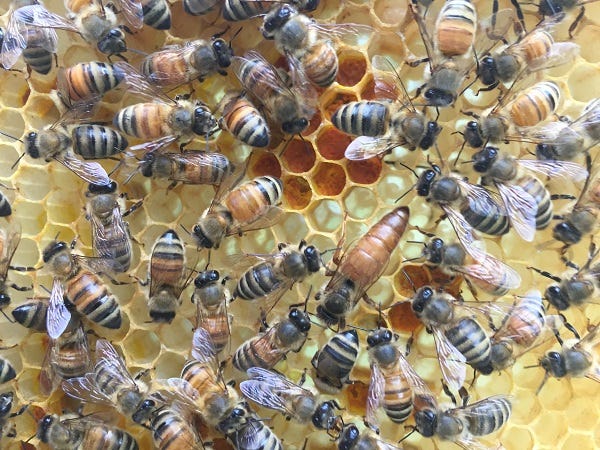Cost of starting or replacing a honey bee colony
Make the most of your beekeeping investment and understand cost versus value.
A common question I hear: How much does it cost to get started in beekeeping? Aside from newbies (or newbees), right now incredible hive losses are being reported across the United States. Project Apis, a non-profit dedicated to science supporting beekeeping, conducted a survey of more than 700 beekeepers reporting an average of more than 60% winter loss. The replacement cost they include in their results is very conservative—about $200 per hive—which is the average cost of a nucleus of bees. Since beekeepers that lost colonies generally still have their equipment, it’s logical to assume the replacement cost would be the cost of bees. However, the cause of high colony loss remains to be seen. Is it a pathogen? Will beekeepers need to retire their equipment and start fresh? More research is needed.
For folks getting started, let’s take a look at the current market hive cost in my region of North Carolina aside from the cost of hive tools, frame holders, extraction equipment, bee suit and/or veil, and a hive stand. The foundational cost we’ll look at includes one Langstroth hive with a brood chamber and single super, and a package of bees.
Based on current market rates in North Carolina, the cost of setting up a new hive with a package of bees is approximately $400
This considers a Langstroth 10-frame medium setup with 3 boxes and a package of bees. One would need more boxes for the honey flow. Generally the lower 2 mediums are considered the brood space. From my experience, colonies lay brood throughout when no queen excluder is used. I’ve seen brood in 4th or 5th supers. (If these terms are new to you: Langstroth boxes come in 3 sizes: deep, medium, and shallow. Langstroth is a common hive style with boxes that stack vertically and have 8-to-10 frames each. Traditionally, deeps are used for the lower brood chamber and the smaller sizes are used as “supers” where the bees store their honey. You can also use all mediums, which is what I run. A package of bees is approximately 3,500 workers and a laying queen.)
Hive supply cost
$21.95 Screened bottom board
$23.25 Telescoping top cover
$17.50 Inner cover
$189.00 3 mediums with frames ($63.00 per medium with 10 frames)
$18.00 per medium
$45.00 10 assembled frames with wax foundation ($4.50 per frame)
$1.50 Entrance reducer
$145.00 package of bees*
$398.20 Total
*$205.00 Nuc - Some folks choose to get a nucleous colony instead of a package. A nucleous colony of bees includes 5 frames of drawn comb, brood, pollen, honey, workers, and a laying queen. If one opts for a nuc, then the total cost of starting a hive is $458.20.
Keep in mind these numbers don’t include varroa management, honey extraction, pest management, supplements, feeder, or other hive management expenses.
Cost of replacing a hive
To me, setting up a new hive and replacing a hive are not equivalent. The cost to replace a hive is almost unquantifiable.
How do you put a value on:
Lost hive products? (Honey crops, beeswax, propolis, pollen, etc.) Depending on the time of the year one loses a hive, you could miss out on the honey flow and other seasonal products. A package of bees in the early spring is generally not going to produce excess honey in its first season. That colony focuses all resources on building comb. The bees require 8 lbs of honey to produce 1 lb of wax. The bees can’t raise brood and foragers without comb, and they need to produce wax to build comb. These packages also need pollen to provide proper nutrition for their brood, so this would be another hive product the beekeeper misses out on in the colony’s first year. Newer colonies need every resource for themselves.
Bee genetics? It’s hard to attach a value to colonies that have descended from bees in your region well-adapted to your unique climate. Replacing a lost colony with local genetics may be a challenge. I noticed the majority of bee package suppliers in my region of North Carolina are selling nucs or packages sourced from New York, Georgia, and South Carolina. It’s rare to find local genetics.
Drawn comb? One can’t buy fully drawn wax comb frames unless buying used equipment. Drawn comb is highly valuable because it gives colonies a space to grow if they’re low on resources, and it gives immediate space to store honey during the flow. As I mentioned, wax production is highly resource-driven with 8 lbs of honey required to produce 1 lb of wax.
Lost time? Depending on when a hive is lost and replaced, the beekeeper misses out. Replacing a colony can’t be done at any time. The beekeeper needs to strategically time the replacement based on their region. In my area of North Carolina, one can’t start a package in late summer—or even early summer. I bought a nuc in July during my first year of beekeeping. Since I was new, I had no drawn comb. I fed them all summer and fall. They couldn’t build comb fast enough to grow their colony size adequately. The timing was off. They didn’t have the population to bring in enough resources for winter—even with supplemental feeding. So if a colony is lost in June, it could be a year before the beekeeper can successfully get started again.
I have a hard time assigning values to these factors, so I won’t. If you have a method or idea of valuation, please comment and let me know.




